
How to Make Your Own Black Chalks

![]()
![]()
![]()
How to Make Your Own Black Chalks
The following procedure will give you some nice black chalks, better in many ways than their commercial counterparts. This recipe replaces another (less ideal one) that I showed until early 2002. The binder in this formula is "black Roman earth," one of the dry Italian earth pigments available at Williamsburg Paint. This pigment binds the same way as the previously recommended medium gray pencil clay, a binder for crayon making, but since Roman earth is black, it doesn't spoil the intensity of the bone black. I show three hardnesses that represent the full range. The soft recipe is very soft, so don't load it into a portcrayon -- it could easily break under pressure. Even the harder sticks are more breakable than factory made chalks, and must be handled with care. They are much more likely to break under pressure from the portcrayon. To help stabilize the softer chalks, I am rolling a sleeve of paper around them before installing in the portcrayon.
In researching recipes, I found that the historical record contains a large array of additives, some quite exotic. One recurring ingredient is soap. I tried several recipes with soap and found that pure liquid uncolored soap can increase friability and modify the spreading and sticking action on paper. Black pigments are a little bit uncooperative compared with other common colors used in crayon making. Black requires more binder to hold together, so "enough" binder for making a stick makes marking on paper difficult. The softer sticks make easily scuffed drawings. A little soap encourages the pigment to release from the stick when drawing, and once on the paper, the mark holds its place under light abrasion. I include the optional soap formula below, so you can try it yourself.
The pigments are available from different suppliers, whose urls are listed in the supply list below.
Important: If you do not intend to use the recommended blue paper, omit the Phthalo Green. If you use another blue paper, you may wish to experiment with other pigments to cancel the red cast over cool paper.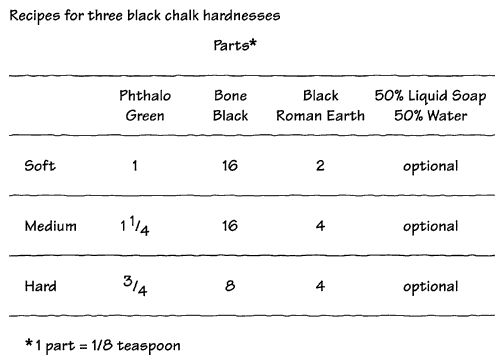
1newspaper to absorb moisture while rolling out chalks
2spacer, such as a wood dowel
3ultra fine sieve
4broad flat blade for rolling dough
5Bone Black, PBK9. This is an intense black made of calcium phosphate/carbon. available at Sinopia (www.sinopia.com)
6Phthalo Green, PG7 F AP. Cancels the red cast in the black. Available at Sinopia (www.sinopia.com)
7Italian black Roman earth dry powdered pigment, available at Williamsburg Paints (www.oilpaint.com)
8mixing knife
9distilled water or optional soap solution in a "drop controlled" dispenser. To make soap solution, mix 50% water with 50% Dr. Bronner's Pure Castille liquid soap (aloe vera version), or other pure, uncolored, liquid true soap.
10measuring spoons
11a glass or plastic surface for mixing dough
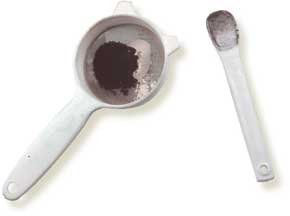
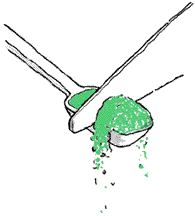
![]()
![]() Measure ingredients into sieve. Make sure to level the measuring spoon
to control proportion accurately.
Measure ingredients into sieve. Make sure to level the measuring spoon
to control proportion accurately.
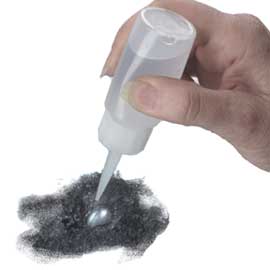
![]()
![]() Sift and mix the powders onto glass or plastic.
Sift and mix the powders onto glass or plastic.
Note: The phthalo green is so strong, it is possible to overdo it. It might be a good idea to add slightly less green than the amount shown above, then test it on the blue paper by finger rubbing a small sample together with a few strokes of the soft white Conte. If you get a reddish color cast in the tone, sift just a little more green onto the pile, mix well, and test again. If major adjustments are made, remember to keep the binder proportionate to original recipe.
![]()
![]() Add only enough distilled water or soap solution to just moisten.
Add only enough distilled water or soap solution to just moisten.
![]() If using the soap
solution, keep your fingers away from your eyes!
If using the soap
solution, keep your fingers away from your eyes!
Better to add too little first, blend, and add gradually until right.
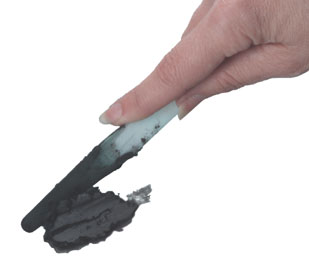
Dough should be stiff, and just moist enough to hang together without being
so gummy that you can't smooth the surface with mixing knife.
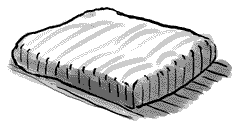
![]()
![]() With your mixing knife, shape a slab just over the height that your
rolled chalk will be, and control the expected length to something manageable
for drawing.
With your mixing knife, shape a slab just over the height that your
rolled chalk will be, and control the expected length to something manageable
for drawing.
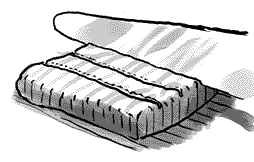
![]()
![]() If you want equal portions to make equal sized sticks, premark your
slab with the mixing knife.
If you want equal portions to make equal sized sticks, premark your
slab with the mixing knife.
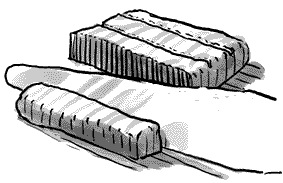
![]()
![]() Cut away section for rolling and place on newsprint.
Cut away section for rolling and place on newsprint.
Newsprint will absorb excess moisture and permit free rolling. Glass or plastic seems to encourage sticky resistance.
Note, this dough is not so elastic that you can begin with a huge chunk and roll it down and down into a narrow stick. It will resist this treatment by coming apart as you roll. This is why I recommend that you make this crude stick shaped cut-out before you roll.
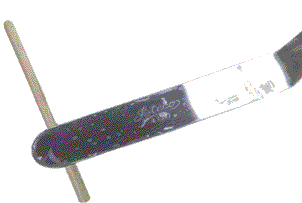
![]()
![]() With a large flat blade, roll stick of dough, controlling elevation
with wood dowel, selected for correct diameter.
With a large flat blade, roll stick of dough, controlling elevation
with wood dowel, selected for correct diameter.
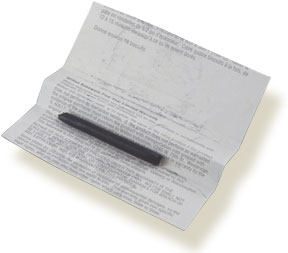
![]()
![]() Place tender stick in open wedge (like creased, bent tag board) to prevent
curving while drying.
Place tender stick in open wedge (like creased, bent tag board) to prevent
curving while drying.
Stick should be allowed to dry for two or three days.
Do not try to accelerate drying time by putting in oven. Stick will weaken.
![]()
![]()
![]()
![]() Next
Page: Supply List: Black and White Chalk
on Blue Paper
Next
Page: Supply List: Black and White Chalk
on Blue Paper
Rebecca Alzofon can be e-mailed
at rebecca@art.net
This page updated July 16, 2003
![]() 1999 by Rebecca Alzofon.
All rights reserved.
1999 by Rebecca Alzofon.
All rights reserved.